DENMARK

|
|
|
|||
|
The Crowned Arms |
|||
|
|
|||
|
Erik VI, Menved |
1286-1319 |
||
|
King Erik
Menved was buried in St. Bend’s church in Ringsted next to his queen
Ingeborg. Over their grave was a brass plate, truly royal ornamented,
and almost three meters in length. |
|||
|
Christopher II |
*1276-†1332 1st term 1320-1326 |
||
|
|
|||
|
Erik Christoffersen |
*1307-†1332 co-regent 1st term 1321-1326 |
||
|
|
|||
|
Valdemar III |
*~1314-†1364 Duke of Schleswig
1325-1326 King of Denmark
1326-1329 Duke of Schleswig
1330-1364 |
||
|
Seals of Waldemar III Petersen
32a, 32b, 33 32a Seal
of majesty of Waldemar III, 1327 L.: X WALDMA[RVS - D]EI - GRA -
DANOR[VM SCLAVOR q' REX] 32b
Counterseal of Waldemar III, 1327 Crested
helmet: Buffalo’s horns set with four sets of peacock feathers L.: [GALEA - WALDEMAR]I-D[EI GRA - DANOR - SCLAVOR q REGIS. D.: 1327 Okt. 10 O 33 Seal
of king Waldemar III A
three-leaved crown L.: X[SIGNVM :WALDEM]ARI:DANOR' -
SCL[AVOR' q'] REGIS. D.: 1326 Aug. I5 |
|||
|
Christopher II |
1320-1332 2nd term 1330-1332 |
||
|
|
|||
|
Erik Christoffersen |
Co-regent 2nd term
1330-1332 |
||
|
|
|||
|
Interregnum 1332-1340 |
|||
|
|
|||
|
Valdemar IV Atterdag |
*1320-†1375 King of Denmark 1340 Duke of Estonia
1344-1346 |
||
|
Seal and counterseal 1344 Petersen suppl 1a-b Suppl. 1a. Woldemarus,
Danorum Sclavorumque rex et dux Estoniæ. Kongen med Krone, Scepter and orb,
the field srtrewn with roses L.: .....EMARVS DEI GRA DANOR' SCLAVOR' QVE REX
ET DVX ESTO ..... Suppl. 1b. Counterseal:
Arms: Strewn with hearts, three
crowned lions passant
Seal and counterseal, 1345-‘52 Petersen
39a-b 39a Woldemare, choning der Denen vnd der Wende.. L.: X WALDEMARVS : DGI : GRACIA : DANORVM :SCLAVORUM Q REGIS ET DUX ESTONIÆ|. 39b Counterseal Arms: Strewn with hearts, three crowned lions
passant L.: CLIPEVS :
WA[LDEMARVS DEI GRA]CIA:DAN[ RVM Q: SCLAVORVM . REGIS : ET : DVCIS :
ESTONIÆ]. Date: 1345; 1346; 1347; 1352 |
|||
|
Secret Seal of King Albrecht, 1376 Petersen 51 Albrecht
was count of Mecklenburg, heir of
Denmark, count of Schwerin,
Stargard and Rostock. Arms: Three crowned lions passant guardant L.: X S'[A .......... RE]G[IS = ]DACIE ..... OR. Date: 1376 .02.14 |
|||
|
House
of Norway |
|||
|
|
|||
|
Oluf II (IV) |
*1370-†1387 King of Denmark
1376-1387 KIng of Norway
1381-1387 |
||
|
A crown in
relation with the arms appears in the end of the 14th century.
Seal and counter seal of Oluf II, 1376 Petersen
47a-b a Seal of Majesty: The young king, crowned, sitting on his
throne L.: X s olavi dei gracia dano[rum] sclavorum
gothorum q regis b Counter
seal: Strewn with hearts three crowned lions passant guardant L.: X clipeus olavidei gracia danorun sclavorum
gothorum q regis
Seal ad causas1377 Petersen
46 Crown
crested with cross L.: X s olavi dei gracia regis danorum ad causas
Seal of Oluf II 1376-1385 Petersen
48 Arms: Strewn with hearts three crowned lions
passant guardant Crown: Of three lilies (as in 1377) L.: X secretum olavi dei gracia danorun sclavorum
gothorum q regis
Coat of arms of King Olaf IV of Norway, Olaf II of
Denmark. Contemporary wall sculpture
near his grave. Cloister Church of Sorø, Ringstead, Denmark Arms: Crowned lion with curved axe The shield
hanging from a nail Following
his death at Falsterbohus, Olaf's mother was proclaimed
“all powerful lady and mistress and the Kingdom of Denmark's Regent”. Denmark
had at the time no provision that enabled a woman to rule in her own right.
The next year Norway proclaimed her Norway's “reigning queen” After the
defeat and overthrow of King Albert in 1389 she was proclaimed “all powerful
lady of Sweden”. On 13 June 1397, she was able to unite the three
Scandinavian kingdoms in a personal union under one crown for her
successor Eric
of Pomerania by
the Kalmar
Union. |
|||
|
Margarethe I |
*1353-†1412 Queen of Denmark 1387-1396 |
||
|
.
Seal
ad causas of Margarethe, 1388 Petersen
54 Square cross charged with a crown L.:
sigillum regni dacie ad causas. Date: 1388 01. 21
Seal of Majesty of Margarete, 1388-03-06 Petersen
58 The queen sitting in majesty L.: [S. MARGARETE. DEI GRACIA. RG]GlNE NORWEGIE: ET : SVECIE AD CAVSAS]. 1375-’76
Margaret was the sister of Christoffer. The arms
with the lions are on the seal 1375/76 (Petersen n° 53). Albrecht,
by God’s grace duke of Mecklenburg was heir of Denmark, count of Schwering,
and lord of Stargard and Rostock I sexbladet Ramme et Skjold, hvori tre gaaende Leoparder uden Hjerter, derover en Tøndehjelm en face med omhængt Klæde og paa Hjelmen et kr. Tyrehoved en face. S’. ALBERTI – REX’. DACIEAG – l)V(1’- CDAGUOPO’. 1387 Nov. 17 |
|||
|
House of Pomerania |
|||
|
|
|||
|
Erik VII of
Pomerania |
*1382-†1459 King of Denmark 1396-1439 |
||
|
His seal used 1399-1436 (Petersen
n° 63) Arms: Cross charged with an escutcheon of three crowned
lions passant guardant. L.: X sigillumerici dei gracia regis danorum ad causas D.: 1399 Nov.
From: Richental Ulrich Chronik
des Konzils zu Konstanz. 1414-1418. Darmstadt 2015 |
|||
|
House
of the Palatinate |
|||
|
|
|||
|
Christoffer III |
*1416-†1448 King of Denmark 1440-1448 |
||
|
|
|||
|
House of Oldenburg |
|||
|
|
|||
|
Christian I |
1448-1481 |
||
|
The kings of Frisia, Ireland, Denmark, Majorca and
Iceland. ca. 1475 Paris, Bibliothèque Mazarine Ms. 3711-1288. |
|||
|
Interregnum |
1481-1483 |
||
|
|
|||
|
Hans |
1483-1513 |
||
|
|
|||
|
Christian II |
*1481-†1559 1513-1523 King of Sweden 1520-1521 164th knight of the Fleece, Barcelona 1519 deposed 1523 |
||
|
Portrait of King
Christian II By Jan Gossaert, 1529. Coll. Fondation Custodia, Paris The
king surrounded by the arms of the kingdoms of Denmark, Norway and Sweden and
the terrritories of Wenden, Schleswig, Oldenburg, a Cross, Holstein and
Stormarn |
|||
|
Frederick I |
1523-1533 |
||
|
|
|||
|
Christian III |
1534-1559 |
||
|
Petersen
122b 1546 |
|||
|
Frederick II |
1559-1588 |
||
|
|
|||
|
Christian IV |
1588-1648 |
||
|
Kirkedørens
portal, Frederiksborg |
|||
|
Frederick III |
1648-1670 |
||
|
|
|||
|
Christian V |
1670-1699 |
||
|
|
|||
|
Frederick IV |
1699-1730 |
||
|
|
|||
|
Christian VI |
1730-1746 |
||
|
|
|||
|
Frederick V |
1746-1766 |
||
|
|
|||
|
Christian VII |
1766-1808 |
||
|
|
|||
|
Frederick VI |
1808-1839 |
||
|
Frederick
VI ,( 28.01.1768 – 03.12.1839) was King of Denmark from 13.-03.1808 to 03
12.1839 and King of Norway from 13.03.1808 to 02.
07.1814, making him the last king of Denmark–Norway. From 1784 until his
accession, he served as regent during his father's mental illness and
was referred to as the "Crown Prince Regent" (kronprinsregent). For
his motto he chose God and the just cause (Danish: Gud og den retfærdige sag) and since
the time of his reign, succeeding Danish monarchs have also chosen mottos in
the Danish language rather than the formerly customary Latin.
Loss of Norway
1814 |
|||
|
Christian VIII |
1839-1848 |
||
|
Danish West Indies, 20 skilling 1839-‘48 |
|||
|
Christian VII |
1848-1863 |
||
|
Danish West
Indies, 1 cent, 1859 Denmark
became a constitutional monarchy on 5 June 1849. A new
constitution emerged, separating the powers and granting
the franchise to all adult males, as well as freedom of the press,
religion, and association. The king
became head of the executive
branch. The legislative
branch consisted of two parliamentary chambers; the Folketing, comprising members elected
by the general population, and the Landsting
(1849-1953), elected by landowners. Denmark also gained an
independent judiciary. [1] |
|||
|
Line of Glücksburg |
|||
|
|
|||
|
Christian IX |
1863-1906 |
||
|
Loss of Schleswig-Holstein at the Second
Schleswig War (1864). |
|||
|
Frederick VIII |
1906-1912 |
||
|
Postcard of KIng
Frederick VIII and Queen Louise (1907) Arms
of Denmark with mottoes Omnia cum deo
nihil sine deo / Dominus mihi adjutor |
|||
|
Christian X |
1912-1947 |
||
|
|
|||
|
Frederick IX |
1947-1972 |
||
|
Until
around 1960 Denmark also had a large coat of arms. Both were used by the government.
In 1959, the large coat of arms changed status and became the royal coat of
arms - that is a coat of arms for the king and the royal family. The large
coat of arms is inspired by one which was designed in 1819 and adopted by
king Frederik VI. The large
coat of arms comprise symbols representing all parts of the Danish kingdom -
or to be precise: only territories that are still part of the Kingdom of
Denmark. In the coat of arms shown to the left the upper left part of the
shield (the three lions) represents Denmark. In the lower part the three
crowns (only two are visible) represents Sweden, this is for historic
reasons. The polar bear represents Greenland and the ram represents the Faroe
Islands. The two lions in the upper right side represents the principality of
Slesvig. Until 1972, it also included other symbols representing
principalities in Germany and parts of present-day Sweden that used to be
ruled by the Danish king.
|
|||
|
Margarethe II |
1972- |
||
|
In 1972
when King Frederik IX died
and Margrethe II became
queen the coat of arms of the royal family was redesigned, and today it only
comprises symbols representing the current parts of the Danish Kingdom. The
new arms were adopted by allerhøjete resolution af 5. juli 1972. See illustration in the head of this article The smaller arms of Denmark consisting of the shield
with the hearts and the lions and crowned with the royal crown, are used by
the sovereign and the institutions of state. |
|||
|
Marshalled Arms |
|||
|
After the deah of King
Oluf in 1387, the arms of the parts of the personal union of Denmark, Norway
and Sweden were displayed together in alliance by Queen Margarethe for a
short time. By her successor Eric of Pomerania the arms of the personal union
were marshalled on one single shield. Æ Greater Royal Arms of Denmark |
|||
|
Folketing |
|||
|
The uncrowned arms
are used by the Folketing, the
legislative power. |
|||
|
Police |
|||
|
The
Danish Police is subordinated to the Ministry of Justice.
Hand and Eye of the Danish Police Domkirkeplads 5, Rosensgade Århus (DK) The
Danish police originated in 1682, when King Christian V. appointed a chief of
police for Copenhagen to enforce regulations concerning the social order, in
the meantime called "the police". From 1683 he was also given
authority over the market towns, where townspeople should act as his proxy.
In a regulation on the police administration of 1701, this was changed to
that townspeople were assigned to the office as police chiefs Rules on
police matters were not included in Christian V’s Danish Law of 15.04.1683,
but were collected in a number of regulations that were published in 1686.
Denmark's first police officer, Claus Rasch (1639-1705), who was appointed in
Copenhagen in 1682, received already 23.06.1683 his first general
instruction, after which the police became a special regulatory body that had
to supervise and apply physical power to the compliance of the regulations
using officers. Police
enforcement of the order originally included religious, moral, health and
social issues. Added to this was the task of safety, i.e. protection against
crimes, and finally, the police were left to monitor the social peace in
order to discourage rebellion. These
police duties existed both under the Danish monarchy and in the
constitutional state from 1849, and they are still found in sections 1 and 2
of the Police Act, after which the police must work for security, safety,
peace and order in society, including bringing criminal offense to an end.
and investigate and pursue offenses. The
criminal police outside Copenhagen became a state police in 1911, and from 1919 the criminal police throughout the country were state
police. The police, on the other hand, remained municipal until 1938. In 1938, the Danish police were
organized in a state police, which included police and criminal police. After 2007, the division between police and
criminal police no longer applies. Approximately
approx. 14,000 in the police, including 11,000 police officers (2010). The
police office staff is approx. 1700 people, and the legal staff, which mainly
handle prosecution, amount to 625. There are another approx. 650 civilian
employees and students. With a
reform valid from 2007, the Danish police have been reorganized and
modernized. The reform is based on recommendations from the Vision Committee
for the future police, and has influence on the police organization,
management and governance as well as on establishing 12 new, large police
districts instead of the previous 54 circles ... Read more about politikredse and Rigspolitichefen. Police emblem The
police have since 1687 been provided with ID, from 1701 in the form of a
white stick or wooden handle of the 4 inch length, with a hand on the end,
and an eye inside the hand, and a crown of the wrist, and clouds at the
bottom of the ring on the wooden hand shaft. The eye in the hand, which as a
symbol of the police authority first appeared in police officer Claus Rasch's
seal from 1691, is probably taken from the Old Testament. The
police hand, which was used at the same time as a coat of arms, served as a
badge until the 1890s.
Politihånd Danish Police Museum,
Copenhagen In 1687,
it was decided that police officers as a sign of authority should wear an
emblem of tin with the Copenhagen city arms, as they still did not wear a
uniform. In 1701, the emblem was replaced by a stick, a single hand at one
end In a
police ordinance of 1762, the police sign is described as "a ... stick
... with a hand on the end, and an eye inside the hand, as well as a crown
about the wrist, and clouds underneath the ring on the wood-handle ..." Both the
eye - the all-seeing, the watchful - and the hand – protecting, correcing and
helping - are old symbols of God. The sign was used by the Moors in the 14th
century in connection with the announcement of laws and convictions, Why the
hand with the eye became the symbol of the Danish police, we do not know. The eye
in the hand, first appeared in police officer Claus Rasch's seal from 1691,
is probably taken from the Old Testament. The police hand, which was used at
the same time as charge of the arms, serving as a badge in the 1890s. Gorgets (Ringkrave)
and police badges, beginning 19th –
mid 20th century
Date unknown
Seal of Aarhus between two Hand and Eyes of the Law
Seal of Aarhus, 1356
With tierced arms and collar Coast guard 1848 Loss of Shleswig-Holstein
1864
With achievement of Christian IX (before 1903) Badges |
|||
|
|
|
||
|
|
|
||
|
Copenhagen police badge, obverse and revrse
Police helmet emblem Beginning 19th – mid 20th
century
Cap badge 1900-1950 The
present Danish police was formed in 1919. It consists of 12 districts each
managed by a director, and two minor districts in Greenland and the Faroe
Islands, run by a local chief of police. The district of Copenhagen is
somewhat differently organized due to its size and tasks. Besides the regular
districts other organizations exist that work outside the general police: Rigspolitiet - a nationwide police force with specialized
tasks such as Budgets and Accounts, Building Surveying Department and the
Data Investigating Department (1911/1919) Politiets Efterretningstjeneste - the national security
intelligence agency of Denmark (1939) Politiets Aktionsstyrke - the special forces unit of the
Danish police (1972)
State Police cap badge since 1954
breast badge 1954
Police staff medal 1958 -1994. Police
badge, which the staff was equipped with from 1958. In 1994,
the plastic-laminated identification card was introduced.
State Police |
|||
|
National Security and Intelligence service Politiets Efterretningstjeneste |
|||
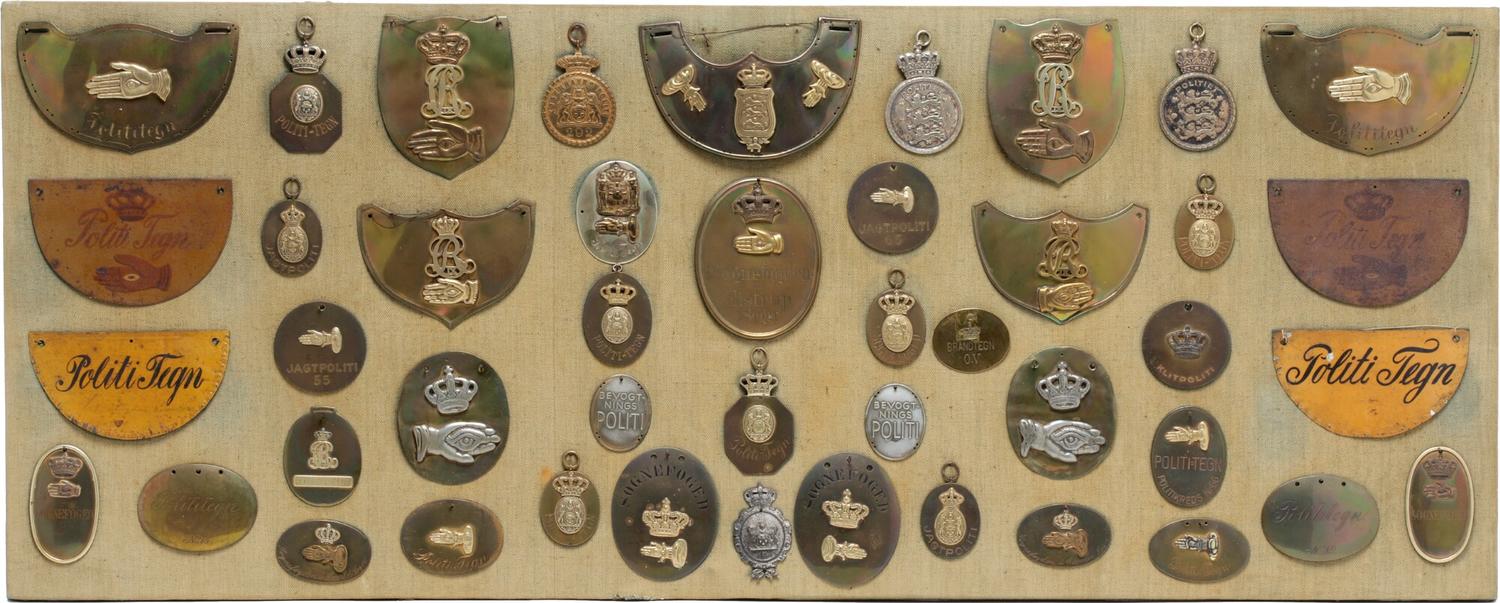
Fine
collection of 45 Danish government signs, from the early 19th century to the
middle of the 20th century. a., police neck collars in brass and enamelled iron
can; policemen in brass and white metal; brass sign for Copenhagen police;
signs for guarding, hunting and dune police; parishes with m.
 © Hubert de Vries
© Hubert de Vries



































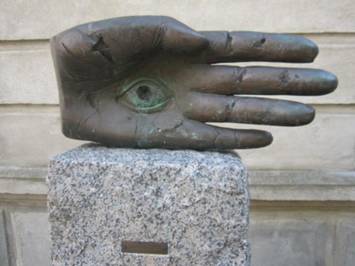
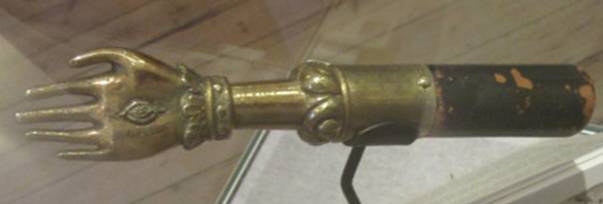
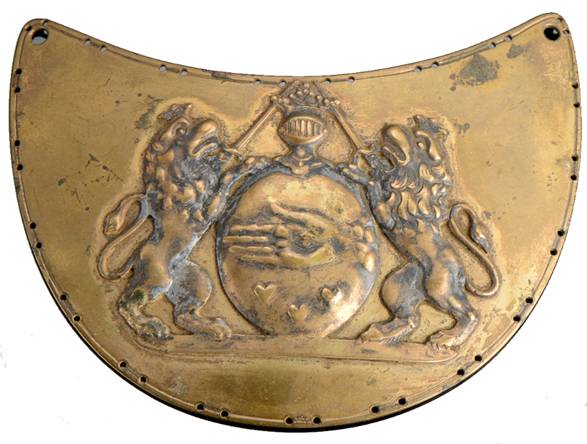
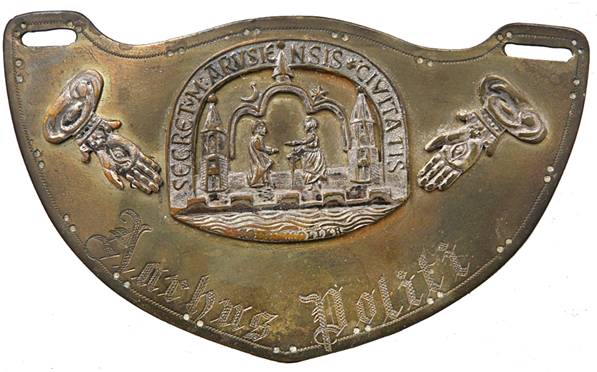
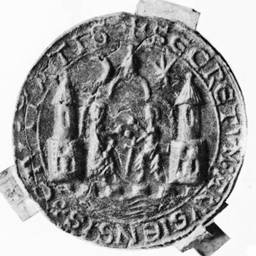
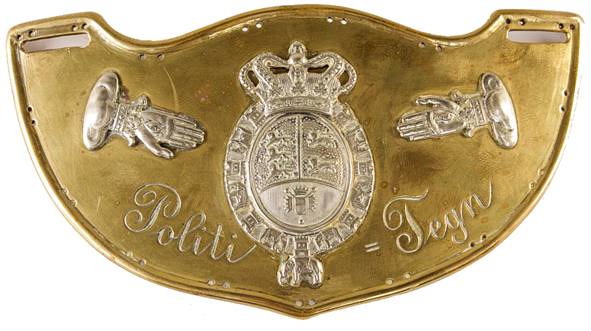
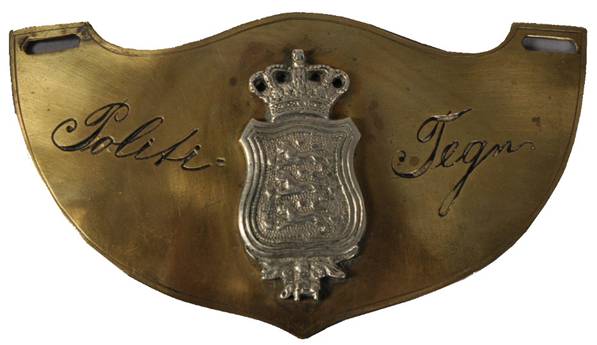
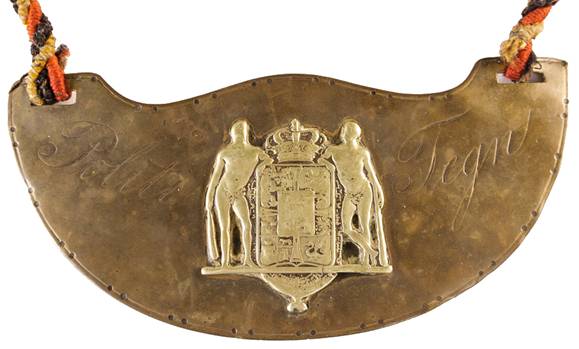
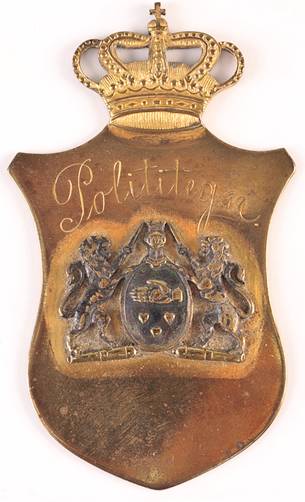
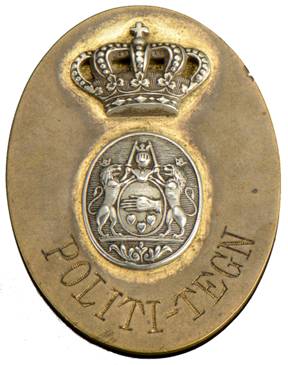
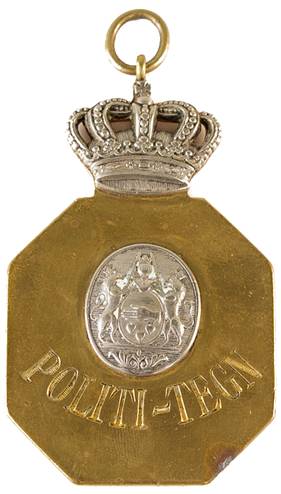
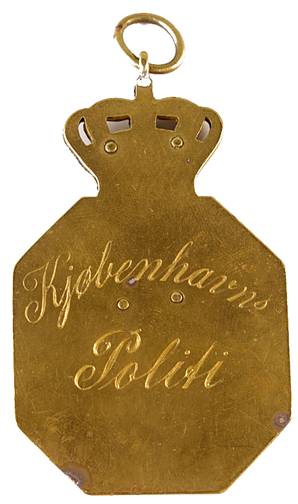
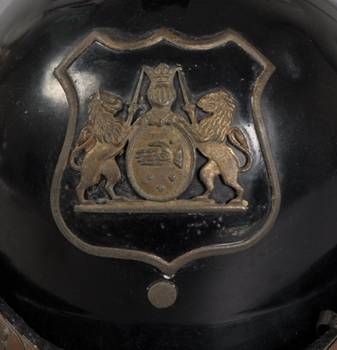
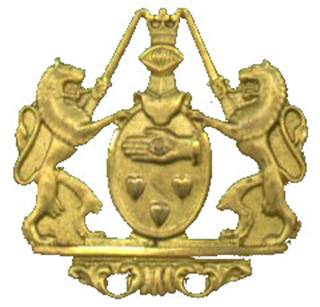
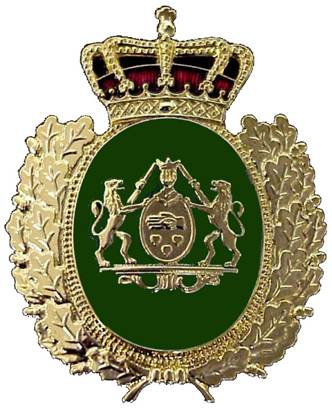
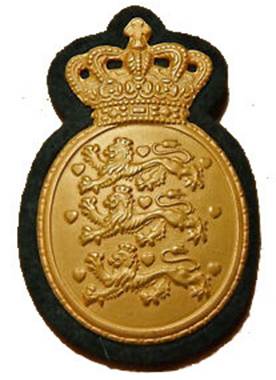
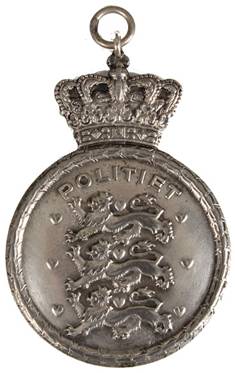
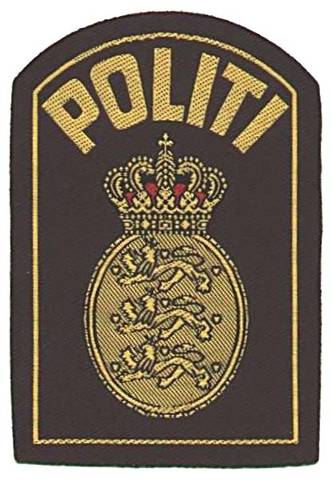
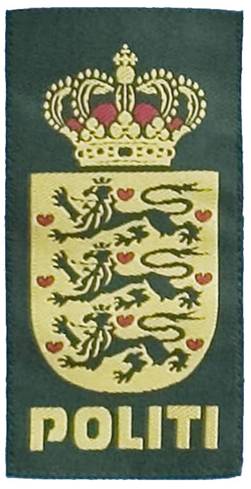
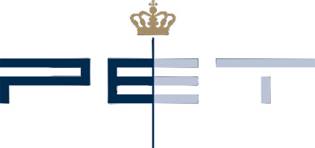
 Heraldry of the World
Heraldry of the World